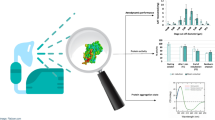Abstract
α1-antitrypsin (AAT) deficiency is a genetic disease in which low serum and lung levels of the antiprotease AAT cause a deficiency of the anti-elastase defensive screen of the lower respiratory tract such that neutrophil elastase is free to degrade the connective tissue of the lung, eventually resulting in emphysema. Intravenous AAT infusion therapy restores lung levels of AAT, but is inefficient, costly and a demanding form of therapy. As an alternative, we evaluated aerosol delivery of human plasma AAT (pAAT) and recombinant DNA-produced AAT (rAAT), as a means of providing anti-elastase protection to the lower respiratory tract. In vitro studies demonstrated that both pAAT and rAAT can be aerosolized into droplets suitable for alveolar deposition without loss of antiprotease activity. When administered by aerosol to individuals with AAT deficiency, pAAT and rAAT each significantly raised lung epithelial lining fluid levels of AAT and anti-neutrophil elastase capacity, with the likelihood that twice daily administration of 100 mg of either form would result in normalization of lung anti-elastase defenses at the alveolar surface. Studies in sheep further demonstrated that the aerosolized pAAT and rAAT were each able to pass through alveolar epithelium and gain access to the interstitial compartment of the lung, thus increasing anti-elastase defenses of the lung intersitium. Therapy was safe and well tolerated in all cases. Aerosol therapy with pAAT or rAAT is a safe, feasible, and likely a biochemically efficacious alternative to intravenous AAT augmentation therapy and merits further long-term studies for clinical therapy.
Similar content being viewed by others
References
Gadek JE, Crystal RG (1982) Alpha 1-antitrypsin deficiency. In: Stanbury JB, Wyngaarden JB, Frederickson DS, Goldstein JL, Brown MS (eds): The metabolic basis of inherted disease. McGraw-Hill, New York, pp 1450–1467
Tobin MJ, Cook PJ, Hutchison CS (1983) Alpha 1-antitrypsin deficiency: the clinical and physiological features of pulmonary emphysema in subjects homozygous for Pi type Z. A survey by the British Thoracic Association. Br J Dis Chest 77:14–27
More JO (1978) Alpha 1-antitrypsin deficiency. N Engl J Med 299:1045–1048, 1099–1105
Hubbard RC, Crystal RG (1988) Alpha-1-antitypsin augmentation therapy for alpha-1-antitrypsin deficiency. Am J Med 84:52–62
Brantly M, Nukiwa T, Crystal RG (1988) Molecular basis of alpha-1-antitrypsin deficiency. Am J Med 84:13–31
Gadek JE, Fells GA, Zimmerman RL, Rennard SI, Crystal RG (1981) Antielastases of the human alveolar structures: implications for the protease-antiprotease theory of emphysema. J Clin Invest 68:889–898
Janoff A (1985) Elastases and emphysema: current assessment of the protease-antiprotease hypothesis. Am Rev Respir Dis 132:417–433
Stockley RA (1983) Proteolytic enzymes, their inhibitors and lung diseases. Clin Sci 64:119–126
Wewers MD, Casolaro MA, Sellers SE, Swayze SC, McPhaul K, Wittes JT, Crystal RG. (1987) Replacement therapy for alpha-1-antitrypsin deficiency associated with emphysema. N Engl J Med 316:1055–1062
Hubbard RC, Sellers S, Czerski D, Stephens L, Crystal RG (1988) Biochemical efficacy and safety of monthly augmentation therapy of alpha-1-antitrypsin deficiency. JAMA 260:1259–1264
Hubbard RC, Casolaro MA, Mitchell M, Sellers SE, Matthay MA, Crystal RG (1989) Fate of aerosolized recombinant DNA producedα1-antitrypsin: use of the epitheial surface of the lower respiratory tract to administer proteins of therapeutic importance. Proc Natl Acad Sci 86:680–684
Hubbard RC, Brantly ML, Sellers SE, Mitchell ME, Crystal RG (1989) Delivery of proteins for therapeutic purposes by aerosolization: direct augmentation of anti-neutrophil elastase defenses of the lower respiratory tract inα1-antitrypsin deficiency with an aerosol ofα1-antitrypsin. Ann Intern Med 111:206–212
Hubbard RC, McElvaney NG, Sellers SE, Healy JT, Czerski DB, Crystal RG (1989) Recombinant DNA-producedα1-antitrypsin administered by aerosol augment lower respiratory tract anti-neutrophil elastase defenses in individuals withα1-antitrypsin deficiency. J Clin Invest 84:1349–1354
Weibel ER (1980) Design and structure of human lung. In: Fishman AP (ed) Pulmonary diseases and disorders. McGraw-Hill, New York, pp 224–272
Bieth JG (1986) Elastases: catalytic and biological properties. In: Mechan R (ed) Regulation of matrix accumulation. Academic Press, New York, pp 217–320
Gorin AB, Stewart PA (1979) Differential permeability of endothelial and epithelial barriers to albumin flux. J Appl Physiol 47:1315–1324
Matthay MA, Berthiaume Y, Staub NC (1985) Long-term clearance of liquid and protein from the lungs of unanesthetized sheep. J Appl Physiol 59:928–934
Crystal RG, Brantly ML, Hubbard RC, Curiel DT, States DJ, Holmes MD: (1989) Theα1-antitrypsin gene and its mutations: clinical consequences and strategies for therapy. Chest 95:196–208
Coan MH, Brockway WJ, Equizabal H, Krieg T, Fournel M (1985) Preparation and properties of alpha 1-proteinase inhibitor concentrate from human plasma. Vox Sang 48:333–342
Beatty K, Bieth J, Travis J (1980) Kinetics of association of serine proteinases with native and oxidized alpha-1-proteinase inhibitor andα-1-antichymotrypsin. J Biol Chem 255:3931–3934
Ogushi F, Fells GA, Hubbard RC, Straus SD, Crystal RG (1987) Z-typeα1-antitrypsin is less competent than M 1-typeα1-antitrypsin as an inhibitor of neutrophil elastase. J Clin Invest 80:1366–1374
Casolaro MA, Fells G, Wewers M, Pierce JE, Ogushi F, Hubbard R, Sellers S, Forstrom J, Lyons D, Kawasaki G, Crystal RG (1987) Augmentation of lung antineutrophil elastase capacity with recombinant humanα1-antitrypsin. J Appl Physiol 63:2015–2023
Smith RM, Spragg RG (1988) Production and administration to dogs of aerosols of alpha-1-proteinase inhibitor. Am J Med 84:48–51
Courtney M, Jallat A, Tessier L-H, Benavente A, Crystal RG, LeCocq JP (1985) Synthesis in E. coli of alpha 1-antitrypsin variants with potential in the therapy of emphysema and thrombosis. Nature 313:149–151
Hubbard RC, Ogushi F, Fells GA, Cantin AM, Courtney M, Crystal RG (1987) Oxidants spontaneously released by alveolar macrophages of cigarette smokers can inactivate the active site ofα1-antitrypsin, rendering it ineffective as an inhibitor of neutrophil elastase. J Clin Invest 80:1289–1295
Agnew JE (1984) Physical properties and mechanisms of deposition of aerosols. In: Clark SW, Pavia D (eds) Aerosols and the lung: clinical and experimental aspects. Butterworths, London, pp 49–70
Author information
Authors and Affiliations
Rights and permissions
About this article
Cite this article
Hubbard, R.C., Crystal, R.G. Strategies for aerosol therapy ofα 1-antitrypsin deficiency by the aerosol route. Lung 168 (Suppl 1), 565–578 (1990). https://doi.org/10.1007/BF02718179
Issue Date:
DOI: https://doi.org/10.1007/BF02718179




